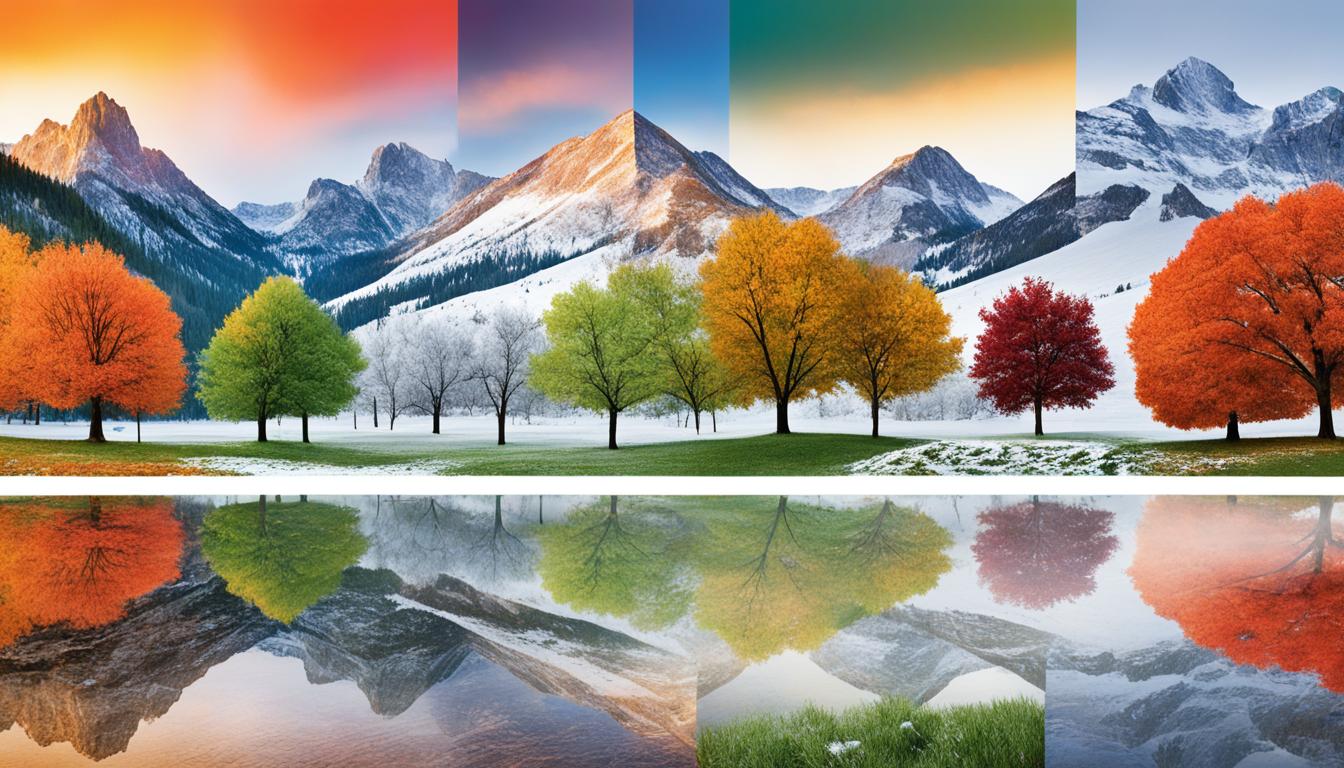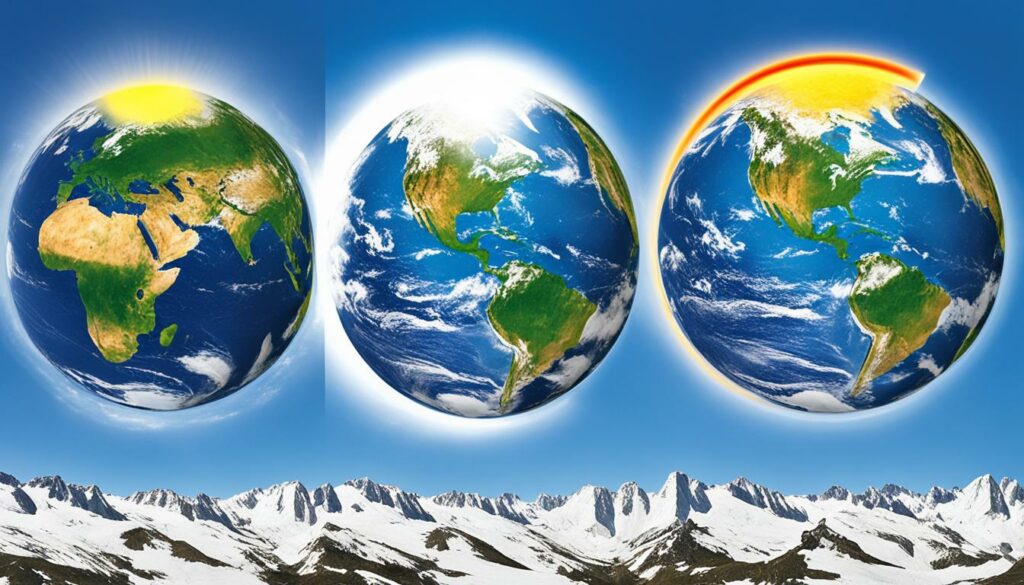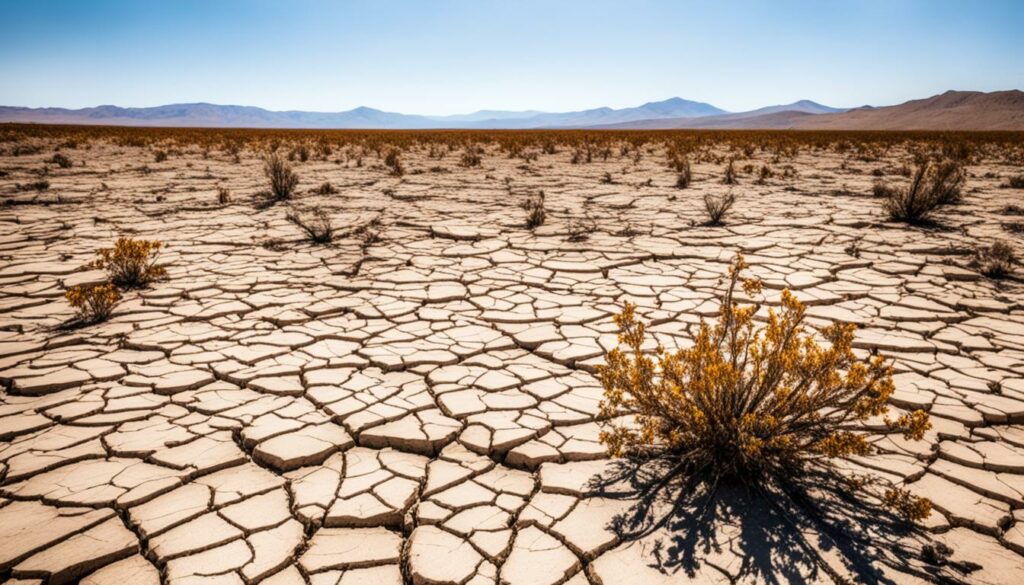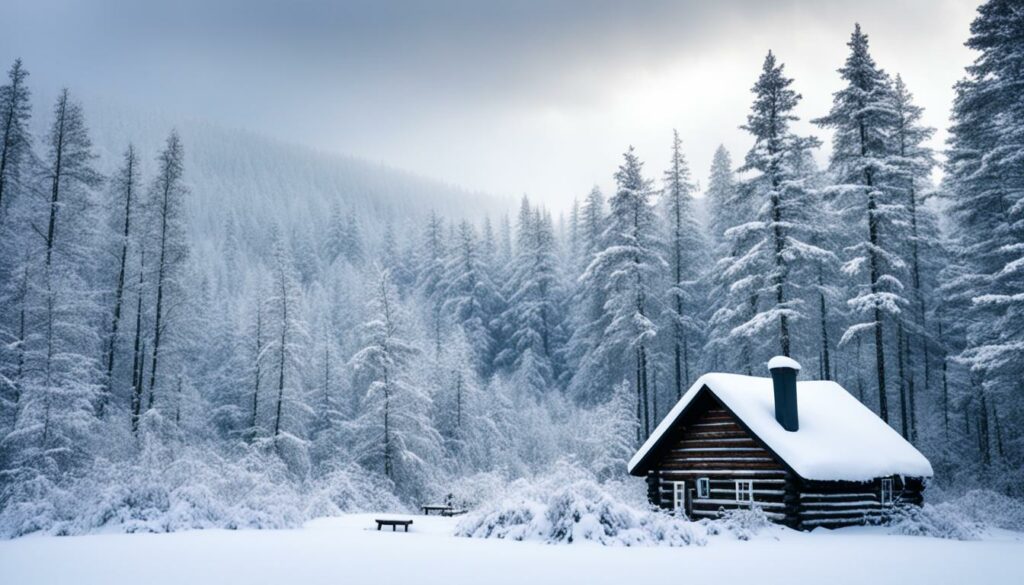Menu

Do you know the Earth is tilted at 23.5 degrees on its axis? This tilt affects how the sun’s energy hits our planet. It’s key to why we have different seasons, climate trends, and changing weather each year.
Astronomical summer starts in the Northern Hemisphere on June 22. This is when it gets the most direct sun. On the flip side, winter begins in December as it gets less sunlight. These changes in solar energy cause daylight and temperature variations.
Knowing about patterns helps us understand seasonal weather. It’s the starting point for really looking into the topic. Teachers can get students interested in watching these changes. They do this by using fun ways to learn, like through special books. These methods help kids see how everything joins together – the Earth, sun, and seasons.
To understand seasonal weather, we must look at two main factors. The Earth’s axis tilt and its orbit around the Sun are key. They create the different weather patterns we see each season.
The Earth is not straight up and down; it’s tilted by about 23.5 degrees. This tilt varies from nearly 22 degrees to almost 24.5 degrees. The tilt causes weather changes and starts our different seasons.
For example, around June 21st, the start of summer in the northern hemisphere, the Earth is tilted so the Sun is right over the Tropic of Cancer. This makes the days longer and the weather warmer.
Near December 21st, or the start of winter in the north, the Earth is tilted the other way. This means the Sun is directly above the Tropic of Capricorn. Days are shorter, and it’s colder in the northern part of the world. This tilt makes our weather and the length of days change a lot.
The Earth goes around the Sun in an oval-shaped path. It’s closest to the Sun in January and farthest in July. This changing distance does affect weather a bit but not as much as the tilt does.
As the Earth goes around the Sun, it receives sunlight in different ways. In summer, the north gets more direct sunlight, making it warm. In winter, the north gets less direct sunlight, so it gets cooler. This shows how the Sun’s light on Earth causes our seasonal changes.
Daylight length also changes, depending on where you are on Earth. Places near the North Pole can have months with no night. In the winter, it’s the opposite: they can have months with no daylight. These long days and nights happen due to the Earth’s tilt and orbit.
The Sun’s key job in making seasons is tightly linked to how sunlight is spread, thanks to Earth’s 23.5-degree tilt. This tilt means sunlight hits Earth at different angles. It causes temperature changes, making the seasons switch.

In the Northern Hemisphere, sunlight hits directly around June 22, starting summer. But in December, the north is away from the Sun, starting winter there. This change in sunlight makes summer in one part of the world while it’s winter in another. It affects the air, changing weather patterns around the globe.
The way sunlight hits Earth greatly impacts our temperature. More direct sun in summer makes it hot. Less direct sun in winter means cooler weather. These changes affect more than just how warm or cold it feels outside. They touch soil moisture, rivers, and weather worldwide. This shift in weather also affects how animals and plants live, making them move, hide, or change what they eat.
The Sun is also vital for plants, helping them grow through photosynthesis. But, even though sunlight reaching Earth has slightly dropped in the last 40 years, it’s still getting warmer. This tells us something else, like human-made gases, is heating up the planet.
It’s important to know how meteorological patterns and astronomical seasons differ to predict the climate right. Meteorological patterns look at the change in temperature each year. On the other hand, astronomical seasons depend on where the Earth is in its orbit around the sun.
Astronomical seasons depend on events like solstices and equinoxes. These include the summer solstice on June 21 and the winter solstice on December 22. The vernal equinox falls on March 21, marking spring’s start, and the autumnal equinox lands on September 22, signalling autumn’s beginning. These dates vary a bit because of the Earth’s movement. Meteorological seasons, however, stick to set months. Spring runs from March to May, summer from June to August, autumn from September to November, and winter from December to February, normally lasting about 91 days each.
Having meteorological seasons that line up with calendar months makes tracking climate trends easier. This system started in the 1900s, giving us a handy way to compare weather year after year. For example, in some parts of the US, autumn was 3.1 degrees warmer than usual, making it the third warmest on record. This info shows how using meteorological seasons helps meteorologists spot climate changes much better.
Also, knowing the difference between these types of seasons helps with planning for businesses and predicting weather events. This is great for areas like farming, dealing with disasters, and planning cities. Services like NOAA help us learn more about seasons, which is very useful.
Seasonal changes hugely affect ecosystems, influencing plant growth and animal habits. Earth’s orbit around the sun and its tilt cause different parts to get changing sunlight levels. This leads to various *seasonal climate shifts* across the globe.

Changes in weather due to seasons greatly change where plants grow. Some places get *longer growing seasons*, improving food and wood resources. But, by 2070, around 20% of tropical plants could find it hard to grow if it gets too hot. This change might cause *cool-weather crops* to have less time to grow.
This shift means farmers will need new plans. Also, more *weeds, diseases* and *pests* may show up, mainly due to milder winters.
| Impact | Effect |
|---|---|
| Longer Growing Seasons | Increased agricultural yields and forest growth |
| Temperature Rise | 20% of tropical plant species unable to germinate by 2070 |
| Cool-Weather Crops | Shorter growing seasons in certain regions |
| Extended Seasons | Increased weed, disease, and pest pressures |
Animals change their habits to deal with *seasonal climate shifts*. In colder areas, they might look for new food, move to warmer spots, or sleep through winter. For instance, European butterflies have flown 114 km north between 1990 and 2008 to keep cool.
The effects of climate change put 8% of animal species at risk. Events like the Australian bushfires from 2019 to 2020 killed about one billion animals. This highlights how severe climate change can be for wildlife.
So, farmers and those who protect nature must be ready for these changes. It’s key to act fast to reduce any harm and use new chances wisely. Dealing well with *seasonal climate shifts* matters a lot for keeping our ecosystem healthy.
Spring weather changes a lot and wakes up nature. It happens because the Earth’s tilt and its path around the sun change. This causes the weather to shift in many ways, like temperature and rain.
Spring is known for more rain and warmer days. In places like the United States and the United Kingdom, it’s from March to May. This time brings longer days and starts melting snow.
It’s also when plants start growing again. In countries like those in Southeast Asia, spring means heavy thunderstorms as part of the summer monsoon. Places in the Southern Hemisphere, like Australia and New Zealand, have spring from September to November.
Spring’s weather can be really surprising. Tornadoes are more likely to happen, especially in North America. They come from warm air meeting cold air, which can create very strong winds – up to 180 miles per hour.
There are also lots of heavy rains and big storms in spring. This makes the season very active. In the UK, the #BlossomWatch campaign is all about spotting the first flowers of spring. It shows that spring is a time for new beginnings.
In the last few years, summer weather has shown us many highs and extreme conditions. For example, in July 2023, the average global temperature hit a record high of 15.8°C (60.4°F). This figure was 1.12°C (2.02°F) above the 20th-century average. July 6, 2023, saw temperatures soar even further to 17.23°C (63.02°F).

Summer is now often linked with heatwaves, which can have terrible effects. In India, over 170 people died in a heatwave. Meanwhile, Phoenix, Arizona, saw extreme temperatures above 110°F for 31 days. On July 16, an airport in Iran felt an incredible heat index of 66.7°C (152°F).
Europe too faced some blistering temperatures. Places like Catalonia, Spain; Verdun, France; and Rome recorded extremely high temperatures. Greece experienced its largest wildfire ever, and Canada suffered its worst wildfire season, burning over 70,000 square miles since May. These events show the serious impact of rising seasonal temperatures, made worse by climate change.
Extreme summer weather doesn’t stop at high temperatures. In 2023, regions such as Myanmar and Pakistan were hit hard by Cyclone Mocha. This storm brought winds of up to 155 mph. Typhoon Mawar also made its mark by hitting Guam as a powerful Category 4 storm. Not just in tropical areas, but also in southern California, where Hurricane Hilary was the first hurricane in over 84 years. Florida faced Hurricane Idalia, a Category 3 storm with winds of 125 mph.
Flooding is another issue in the summer. Regions like the Mediterranean suffered greatly, with the village of Zagora getting 30 inches of water in a day. Libya and Mexico were also hit by these floods. In Mexico, at least seven people died in Jalisco. Even milder areas like Vermont and Kentucky saw historic floods. This shows that the effects of extreme summer weather are widespread and varied.
| Location | Event | Record | Date |
|---|---|---|---|
| Global | Hottest Month | 15.8°C (60.4°F) | July 2023 |
| Global | Hottest Day | 17.23°C (63.02°F) | July 6, 2023 |
| Phoenix, AZ | Heat Streak | 31 days > 110°F | July 2023 |
| Iran | Heat Index | 66.7°C (152°F) | July 16, 2023 |
| Europe | Wildfire | Largest in EU (Greece) | Summer 2023 |
To understand summer weather’s full impact, we need to learn about these events. Rising temperatures caused by climate change make these situations more severe. We must be ready and have the right plans to deal with these issues.
Autumn is a time of change. It marks the end of summer’s intense heat. The days grow shorter and cooler as we move towards winter. Interestingly, ‘autumn’ comes from an old French word and has been used in English since the late 1300s.
Not all places experience autumn in the same way. Near the equator, it might not feel like a change at all. However, in polar areas, the drop in temperature is very noticeable. Mountains often get more snow than the flatlands, and coastal spots face more storms.
In the Northern Hemisphere, summer starts on June 1 and ends on August 31. In 2021, the U.S. had its warmest summer ever. According to the NOAA, temperatures reached 74.0 degrees Fahrenheit. But the summer of 1936, known as the Dust Bowl Summer, was even hotter.
Autumn is a time for special events. Diwali, an Indian festival, is a key example. Celebrated between October and November, it highlights victory over darkness. Events like this make autumn a special season.
Here are the key points about autumn weather:
| Aspect | Characteristics |
|---|---|
| Temperature | The days get cooler as winter comes closer. |
| Weather Variability | Places far from the equator see big temperature changes. Those near the equator stay more stable. |
| Precipitation | Mountains get more snow. Coastal areas face more storms. |
Autumn is a season of both calm and change. It’s a time we reflect on the year. The Earth’s position towards the sun is key. It brings us this transition with its mild, serene weather.
Winter weather is known for its cold temperatures and comes with various storms. These can include blizzards, freezing rain, and sleet. These conditions help us learn about weather patterns. We see the Earth lean away from the sun, which brings less sunshine and cooler temperatures.

The cold can be very dangerous. The polar vortex in January 2019 caused parts of North America to feel like the Arctic. Back in January 1994, northeast Kentucky’s temperatures dropped to 20-30 below zero. Such points out the risks when the weather gets extreme.
Winter also brings lots of snow. The “storm of the century” in March 1993 left around 2 feet of snow in Northeast Kentucky. Such events show why it’s vital to understand winter weather. This helps us get ready for what might come next.
Global warming has increased the Earth’s temperature by about 0.8°C in the last 100 years. This has not made winter any less severe; instead, it can make extreme weather worse. World leaders are working together to prevent the Earth’s temperature from rising more than 2°C. However, it’s a tough challenge.
| Event | Impact |
|---|---|
| Polar Vortex 2019 | Arctic conditions in North America |
| Winter Storm January 1994 | Temperatures dropped to 20-30 below zero in NE Kentucky |
| Storm of the Century 1993 | 2 feet snowfall in Northeast Kentucky |
| Ice Storm January 2009 | Largest power outage in Kentucky, 609,000 without power |
Dealing with winter’s harshness requires a strong plan. This is part of the United Nations’ goals to fight climate change, especially through SDG 13. It’s important because 97 percent of scientists believe we’re causing global warming. We must work together to lessen its effects, which have already affected millions in 2018.
By understanding winter weather, we can get ready for its challenges better. This helps us lower the risks and be more prepared for its surprises.
Seasonal changes greatly influence our daily life. They affect everything from what we wear to our plans for fun. I’ll show you how our lives connect with the changing seasons.
On its tilted axis, Earth receives the sun’s energy unevenly. This leads to different weather across the globe. For example, around June 22, the Northern Hemisphere gets the most sunshine and starts summer. But by December, the sun’s warmth lessens, bringing in winter.
Summer means using more electricity to cool our homes because it’s hot outside. Winter makes us turn up the heat indoors. This impacts our bills. It also affects what we wear. Summertime means light clothes and layers. Winter calls for bulky, warm dresses.
What we do for fun changes with the seasons too. Summer is for outdoor fun like swimming and barbecues. Winter is perfect for snow sports. So, our leisure time switches up based on the time of year.
These season changes are vital for farmers. They plant and harvest at certain times to get the best crops. This timing is so important for food and the economy. It affects when we get our food and how much it costs.
The effects reach beyond individual choices. Entire communities and services are involved too. Roads need special care in winter. And during summer, places to cool off safely are provided. This helps everyone, especially those who are more at risk.
Knowing about these seasonal shifts helps us get ready for change. We can manage better and use our resources smarter. By understanding and getting ready for each season, we can enjoy life more.
Seasonal weather changes a lot around the world. The Earth’s tilt of 23.5 degrees is the main cause. This tilt changes how the sun’s energy reaches different parts of the Earth. It’s why some places are always warm and others can be very cold.
In the Northern and Southern Hemispheres, seasons differ greatly. For instance, around June 22, the North Pole points more towards the sun. This means the Northern Hemisphere starts its summer. Days get longer and warmer.
Every December, the situation flips. The Northern Hemisphere turns away from the sun. This brings winter, with short days and colder weather. Meteorologists study these changes to predict the weather.

Equatorial and polar regions have very different climates. The equator has mostly the same weather all year. It follows a cycle of rainy and dry seasons.
Polar regions see huge changes between summer and winter. During summer, it’s light all the time. In winter, it’s dark a lot. This causes big temperature swings and other natural changes.
Understanding these global patterns is key. They affect nature, farming, and what we do daily. There’s a huge system that moves energy around the Earth. It’s like a big weather machine, changing everything from the tropics to the poles.
| Region | Seasonal Characteristics |
|---|---|
| Equatorial | Consistent weather with rainy and dry seasons |
| Polar | Extreme seasonal shifts, continuous daylight in summer and prolonged darkness in winter |
| Mid-Latitudes | Distinct seasons with variable weather patterns |
The past tells us how weather shapes our lives and cultures. In 1748, French thinker Baron de Montesquieu said *cold air* makes people braver and more secure. This shows how closely our behaviour is tied to weather changes over the centuries.
Weather affects our feelings a lot. Rain can make us sad, but sunshine usually makes us happy. These effects on emotions have been felt across time. They’ve even shaped our cultures and ways of life. For example, farming began about 12,000 years ago, connecting us more to one place instead of wandering.
Climates good for farming helped build towns and cities. But too much or too little, called volatility, made it hard to live and grow food. This is why some societies became more equal, while others were not so fair to women.
Back then, taking care of animals shaped how we worked and lived together. It even influenced when babies were born. Facing the weather’s challenges together made people trust each other more. This was shown in old European records and in surveys across 25 countries.
Areas prone to earthquakes saw more religious activity after a quake. People believed more in gods that value good actions. This trust and togetherness were needed for hard times, perhaps because of climate issues. This area is still being studied.
Studying climate from the past isn’t easy. It can be hard to separate its different effects on us. Yet, tools like the U.S. Climate Normals, made from many weather records, help us see trends. The newest Normals show the U.S. has been getting warmer and wetter. Knowing about past weather helps with predicting the future.
The way we predict weather has seen a big improvement thanks to seasonal forecasting and predictive modelling. Now, we can better guess what the weather will be like. This is really important for jobs like farming and planning our cities. Knowing what weather to expect helps us get ready for the worst and improves how we deal with disasters.

A study used NARMAX models to predict summer and winter weather early. It looked at wind patterns in the North Atlantic and how they affect Europe’s weather. This research was published in Meteorological Applications and the International Journal of Climatology. It found these models were very good at guessing the weather for both seasons.
The study showed that regular computer models are not great at guessing summer weather in Europe. They often get it wrong, especially when the weather changes year by year. But the NARMAX models showed they could predict the summer weather accurately. They were able to guess things like temperature and rain very well.
This is a big deal. It shows we can better guess the summer weather, which is usually harder to predict. It also helps us think of new ways to forecast the weather. Forecasting the weather for a season is very different from what you see in daily weather reports.
Many things help make these weather guesses good. For example, the temperature of the sea in the Pacific really affects the wind and weather. This is part of something called the ENSO cycle. Events like El Niño and La Niña can totally change the weather from year to year. Being able to guess this kind of stuff for several months ahead is why seasonal forecasting is so important.
| Model | Accuracy | Publication |
|---|---|---|
| NARMAX | High | Meteorological Applications, International Journal of Climatology |
| Conventional Supercomputer Models | Struggles in Summer | N/A |
In the end, getting better at forecasting the seasons is really important. It helps us prepare for the changing weather. By improving these methods, we can react better to weather changes, making life easier.
Seasonal weather patterns help us understand the Earth’s complex climate. The Earth is tilted at 23.5 degrees on its axis. This tilt causes the sun’s energy to affect different parts of the world during the year. For example, the Northern Hemisphere gets the most heat around June 22, starting summer. Winter begins in December when this half of the Earth moves away from the sun.
The way meteorologists and climatologists see seasons isn’t just about when summer or winter starts. They look at temperature changes impacting our climate and weather. This approach is key for forecasting changes in the weather. Plants and animals in cold places adapt by finding food, moving, or sleeping through winter. Interestingly, even things like Punxsutawney Phil’s weather predictions show how much we care about these seasonal shifts, although his forecasts are about 40% right.
Scientists have made big steps in linking climate change to extreme weather. They’ve looked at events like storms and heatwaves to see how human actions are making them worse. Even though there are many factors at play, these studies are vital for understanding the climate. Since 1880, the Earth’s average temperature has gone up by 1.1°C. Many experts fear that because of this, 2023 could be the hottest year yet. The push is on to lower greenhouse gases and switch to cleaner forms of energy to fight these issues.
Thinking about why we study seasonal weather, it’s clear that it’s vital for everyone from scientists to teachers and leaders. New technology and the science of weather offer better forecasts. These could help us prepare for and lessen the effects of yearly climate changes.
Seasonal changes come from how the Earth is placed and moves around the sun. The Earth is tilted about 23.5 degrees. As it goes around the sun, this tilt makes different parts of the Earth receive sunlight in varying amounts. This leads to hotter or cooler days, creating seasons.
The Earth tilts at an angle, causing the seasons to change. This tilt means the Earth gets direct sunlight in one part of the year and indirect sunlight in another. This is why we have the summer, autumn, winter, and spring seasons.
The Earth moving around the sun creates different weather each year. The Earth’s path isn’t a perfect circle; it’s more like an oval. This makes us lean towards or away from the sun at different points. As a result, we have seasons.
The sun plays a big part in the seasons by shining light unevenly on the Earth. This is because of the Earth’s tilt. In summer, when the sun is directly above, it’s hotter. In winter, when its light is not as direct, it’s colder.
Meteorological seasons are based on the changes in weather. They help us track when it gets colder or warmer. Astronomical seasons are linked to how the Earth moves around the sun. They mark times like the longest or shortest days of the year.
Seasons can change how plants grow and how animals behave. Plants may grow more or less, and some animals move or sleep to cope. This is how they deal with the different weather each season.
Spring brings warmer days and more rain. In places like North America’s Midwest, it can also bring tornadoes. This season is a time of transition from the cold of winter to the warmth of summer.
Summer is when it gets really warm and the days are long. This is great for growing plants. But, it can also bring heavy rain in some places, like Southeast Asia. Hurricanes might happen in coastal areas too.
Autumn means things get a bit cooler. It’s not as cold as winter, but it’s not warm like summer either. It’s also a time when some tropical places can still have hurricanes.
Winter is the coldest season with snow and ice. The top half of the Earth gets less sunlight at this time. That’s why it’s colder. Places with more snow are often far from the Equator.
The changing seasons make us change what we wear and do. We dress differently, heat or cool our homes, and choose activities based on the weather. It shows why it’s important to know about the seasons.
Seasons are not the same in all places. Near the North and South Poles, the changes are really extreme. But, near the Equator, it stays warm most of the year. These differences are due to how the Earth is shaped and moves.
Knowing what the weather was like in the past helps us prepare for the future. It’s useful for farming, city planning, and protecting the environment. Understanding the seasons helps us use resources better.
Today, we can predict the weather more accurately because of new technology. That’s good for farming and when we need to avoid bad weather. It also helps us get ready for the seasons better.